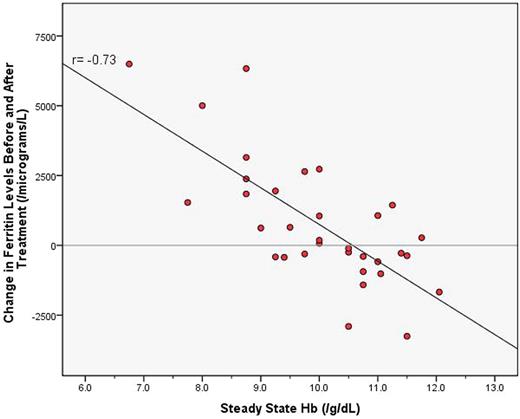Abstract
Abstract 1522
Poster Board I-545
INTRODUCTION
Red cell exchange in sickle cell disease (SCD) reduces the risk of life threatening complications including acute chest syndrome, and thromboembolic stroke. Reduction in Hb S to less than 30% reduces overall blood viscosity and improves tissue oxygenation. With treatment being life-long, concerns over iron loading, patient compliance, blood-bourne infections, and cost could temper its effectiveness.
METHODS/SUBJECTS
A retrospective study of 74 patients with SCD (mean age 37.5, range 19-73) on automated red cell exchange (mean 21.3 exchanges, range 1-74) was carried out for the period September 1995 to January 2009. Primary end points included the effect of consistency of exchange on hospital admission rate and the relationship between steady state haemoglobin (Hb) and serum ferritin (iron loading). The impact of the consistency of exchange was assessed by dividing the patients into 4 groups. A: Regular exchanges at least every 8 weeks. B: Regular exchanges with occasional short breaks. C: 3 or fewer exchanges per year. D: 4 or fewer exchanges in total. Average hospital admission data per year pre- and post- exchange transfusion programme were calculated. Patients were excluded if no exchanges or hospital admissions had happened in the last 4 years. To assess the relationship between ferritin and steady state Hb, the pre-treatment ferritin, latest ferritin, and steady state Hb were recorded. Patients were excluded if they were on iron chelation. Target post-procedure Hb was 10-11g/dL in all patients, with Hb S % <15%.
RESULTS
The 74 subjects received a total of 1578 exchange procedures, with a median of 8.00 units per exchange (range 5-10.5). Median time on erythrocytopheresis was 2.60 years (range 0.0 – 13.0 years). The mean steady state Hb was 10.0g/dL (SD 1.24).
Hospital admission data was available for 67/74 (91%) patients. This included 25 in group A, 11 in group B, 5 in group C and 26 in group D. Fourteen patients in group D were excluded due to no record of admissions or exchanges in the last 4 years. In group A, there was a significant reduction in average hospital admission days per year, from 34.8 days/year (range 0-365, SD 71.4) to 7.60 days/year [range 0-34, SD 9.87 (p<0.005)]. In group B and group C, there was a non-significant reduction in average admission days per year from 38.1 days/year (range 1-124, SD 40.98) to 34.1 days/year [range 0-163, SD 55.14 (p=0.53)] and 45.3 days/year (range 0-75, SD 29.8) to 30.4 days/year [range 4-68, SD 24.48 (p=0.08)] respectively. In group D, there was a non-significant increase in admissions from 11.64 days/year (range 0-43, SD 15.33) to 42.26 days/year [range 3-190, SD 65.75 (p=0.161)].
A slight increase in mean serum ferritin levels was seen post initiation of an exchange transfusion program (pre 2523μg/L (range 11-15990, SD 3198) to post 2659μg/L [range 21-14229, SD 3229 (p=0.10)]. The data from one patient were excluded from analysis because the patient was on iron chelation. There was a strong negative correlation between serum ferritin levels and the patient's steady state Hb (r= -0.73, see graph A). The line of best fit went through no net ferritin change at the Hb level of 10.5g/dL, the midpoint of the target Hb range. This suggests that the ‘top-up’ of patients with a low pre-exchange Hb with extra donor red blood cells (carried out automatically by the exchange machine to get the patient's Hb up to the post-exchange target level) is also increasing the patient's iron loading.
CONCLUSIONS
Reduction in hospital admissions for sickle cell patients on erythrocytopheresis is dependent on a good patient consistency and compliance with treatment schedules. A statistically significant reduction in the average hospital admission days per year is lost when erythrocytapheresis exchanges are further than 8 weeks apart. Iron loading on exchange transfusion correlates to the patient's steady-state Hb, with patients achieving a baseline Hb of less than the target level (10g/dL) increasing their iron load.
Graph demonstrating the correlation between the steady state Hb and the change in ferritin levels (n=33)
Graph demonstrating the correlation between the steady state Hb and the change in ferritin levels (n=33)
No relevant conflicts of interest to declare.
Author notes
Asterisk with author names denotes non-ASH members.


This feature is available to Subscribers Only
Sign In or Create an Account Close Modal